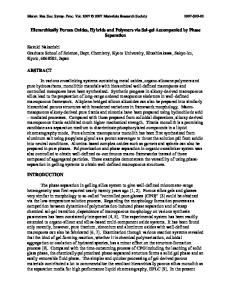Viscoelastic Responses of Inorganic-Oranic Hybrids Polymers
- PDF / 480,633 Bytes
- 8 Pages / 420.48 x 639 pts Page_size
- 111 Downloads / 343 Views
INTRODUCTION Nanocomposites are composite materials consisting of building blocks in the nanometer or tens of nanometer size scales. The properties of nanocomposites are determined not only by the bulk properties of each of the components, but also by complex interactions between different phase and the interfaces between them. Nanocomposite promise to be the wave of the future, having major implications for industry and technology. The types of nanocomposites can be classified depending on the material used, such as ceramic/ceramic, metal/ceramic, metal/metal, metal/polymer, and ceramic/polymer. In this study, we investigated two types of newly developed ceramic/polymer nanocomposites. Since, the ceramic or "inorganic" phase is chemically attached to the polymeric or "organic" phase, these composites can also be refer as hybrid inorganic-organic polymers'. The synthesis of these hybrid inorganic-organic polymers has been achieved over the past ten years. One approach is the application of sol-gel reaction 2 4 , in which the inorganic components are formed in-situ in the hybrid system, through hydrolysis and condensation of mononuclear species. However, owing to the loss of volatile by-products formed in the hydrolysis/condensation reactions, it is difficult to control sample shrinkage during processing. Another approach for incorporate nanoscopic inorganic cluster into organic polymer is to design 343 Mat. Res. Soc. Symp. Proc. Vol. 576 © 1999 Materials Research Society
well-defined inorganic oligomers with specific polymerization site(s) per cluster 5- 13. Each oligomeric cluster has an exactly defined degree of polymerization of n, (RSiO1 .5),, or more precisely, PyRn-y(SiO 1.5)n, where R and P are organic groups. These polyhedral oligomeric silsesquioxane (POSS) macromers have an inorganic silica-like core and are surrounded by n number of organic groups, of which n-y are inert and y are reactive. Further polymerization involving only the reactive "P" sites, results in a linear polymer containing monodisperse, nanosize inorganic clusters attached to an organic polymer backbone. Another type of nanocomposites that have attracted significant attention is the incorporation of layered inorganic component14-23. The varieties of layered inorganic available and the established understanding of intercalation chemistry have attributed to this growing interest. The intercalated polymer-clay system is that the organic polymer layers and inorganic silicate layer are alternatively interstratified at the molecular level. Various polymers have been intercalated into clay galleries. To further overcoming the binding forces between the clay layers, material chemists have synthesized exfoliated polymer-clay nanocomposites. Epoxy resin owning to the ease of process and excellent engineering performance upon curing, it is by far the most commonly used engineering thermoset24 . In this paper, we compare the viscoelastic performance and physical aging behavior of cured epoxy networks containing either mono-functional POSS-epoxy an
Data Loading...











